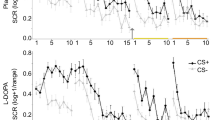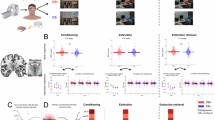Abstract
Prefrontal dopamine loss delays extinction of cued fear conditioning responses, but its role in contextual fear conditioning has not been explored. Medial prefrontal lesions also enhance social interaction in rats, but the role of prefrontal dopamine loss on social interaction memory is not known. Besides, a role for subcortical accumbal dopamine on mnesic changes after prefrontal dopamine manipulation has been proposed but not explored. The objective was to study the involvement of dopaminergic neurotransmission in the medial prefrontal cortex (mPFC) and nucleus accumbens in two mnesic tasks: contextual fear conditioning and social interaction memory. For contextual fear conditioning, short- and long-term freezing responses after an electric shock were studied, as well as extinction retention. Regarding social interaction memory, the recognition of a juvenile, a very sensitive short-term memory test, was used. Dopamine loss was carried out by injection of 6-hydroxydopamine, and postmortem catecholamine levels were analyzed by high-performance liquid chromatography. Prefrontocortical dopamine loss (>76%) led to a reactive enhancement of accumbal dopamine content (p<0.01), supporting the hypothesis that a hyperdopaminergic tone emerges in the nucleus accumbens after prefrontocortical dopamine loss. In lesioned rats, long-term extinction of contextual fear conditioning was significantly delayed and extinction retention was impaired without changes in acquisition and short-term contextual fear conditioning and, on the other hand, acquisition and short-term social interaction memory were not affected, although time spent on social interaction was significantly reduced. Added dopamine loss in the nucleus accumbens (>76%) did not alter these behavioral changes. In summary, the results of the present study indicate that the dopaminergic network in the mPFC (but not in the nucleus accumbens) coordinates the normal long-term extinction of contextual fear conditioning responses without affecting their acquisition, and it is involved in time spent on social interaction, but not acquisition and short-term social interaction memory.
Similar content being viewed by others
Log in or create a free account to read this content
Gain free access to this article, as well as selected content from this journal and more on nature.com
or
References
Bubser M, Schmidt WJ (1990). 6-Hydroxydopamine lesion of the rat prefrontal cortex increases locomotor activity, impair acquisition of delayed alternation tasks, but does not affect uninterrupted task in the radial maze. Behav Brain Res 37: 157–168.
Carter CJ, Pycock CJ (1978). Lesions of the frontal cortex of the rat: changes in neurotransmitter systems in sub-cortical regions. Br J Pharmacol 64: 430P.
Carter CJ, Pycock CJ (1980). Behavioral and biochemical effects of dopamine and noradrenaline depletion within the medial prefrontal cortex of the rat. Brain Res 192: 163–176.
Chaillan F, Marchetti E, Roman F, Delfosse F, Soumireu-Mourat B (1997). Opposite effects depending on learning and memory demands in dorso-medial prefrontal cortex lesioned rats performing an olfactory task. Behav Brain Res 82: 203–212.
Dantzer R, Bluthé RM, Koob GF, Le Moal M (1987). Modulation of social memory in male rats by neurohypophyseal peptides. Psychopharmacology 91: 363–368.
Espejo EF (1997). Selective dopamine depletion within the medial prefrontal cortex induces anxiogenic-like effects in rats placed on the elevated plus-maze. Brain Res 762: 281–284.
Espejo EF, Miñano J (2001). Adrenergic hyperactivity and metanephrine excess in the nucleus accumbens after prefrontocortical dopamine depletion. J Neurophysiol 85: 1270–1275.
Gewirtz JC, Falls WA, Davis MD (1997). Normal conditioned inhibition and extinction of freezing and fear potentiated startle following electrolytic lesions of medial prefrontal cortex. Behav Neurosci 111: 712–726.
Glowinski J, Tassin JP, Thierry AM (1984). The mesocor-tico-prefrontal dopaminergic neurons. Trends Neurosci 7: 415–418.
Goldman-Rakic PS, Selemon LD, Schwartz ML (1984). Dual pathways connecting the dorsolateral prefrontal cortex with the hippocampal formation and parahippocampal cortex in rhesus monkey. Neuroscience 12: 719–743.
Gonzalez LE, Rujano M, Tucci S, Paredes D, Silva E, Alba G et al (2000). Medial prefrontal transection enhances social interaction. I: behavioral studies. Brain Res 887: 7–15.
Grace AA (1991). Phasic versus tonic dopamine release and the modulation of dopamine system responsivity: a hypothesis for the ethiology of schizophrenia. Neuroscience 41: 1–24.
Harden DG, King D, Finlay J, Grace AA (1998). Depletion of dopamine in the prefrontal cortex decreases the basal electrophysiological activity of mesolimbic dopamine neurons. Brain Res 794: 96–102.
Hemby SE, Jones GH, Neill DB, Justice JB (1992). 6-Hydroxydopamine lesions of the medial prefrontal cortex fail to influence cocaine-induced place conditioning. Behav Brain Res 49: 225–230.
Herman JP, Guillonneau D, Dantzer R, Scatton B, Smerdjian-Rouquier L, Le Moal M (1982). Differential effects of inescapable footshocks and of stimuli previously paired with inescapable footshocks on dopamine turnover in cortical and limbic areas of the rat. Life Sci 30: 2207–2214.
Kim JJ, Fanselow MS (1992). Modality-specific retrograde amnesia of fear. Science 256: 675–677.
Kim JJ, Fanselow MS, DeCola JP, Fernandez JL (1993). Selective impairment of long-term but not short-term conditioned fear by the N-methyl-D-aspartate antagonist APV. Behav Neurosci 106: 591–596.
Kolachana BS, Saunders RC, Weinberger DR (1995). Augmentation of prefrontal cortical monoaminergic activity inhibits dopamine release in caudate nucleus: an in vivo neurochemical assessment in the rhesus monkey. Neuroscience 69: 859–868.
Kowalska DM, Bachevalier J, Mishkin M (1991). The role of the inferior prefrontal convexity in performance of delayed nonmatching-to-sample. Neuropsychologia 29: 583–600.
Kurachi M, Yasui SI, Kurachi T, Shibata R, Murata M, Hagino H et al (1995). Hypofrontality does not occur with 6-hydroxydopamine lesions of the medial prefrontal cortex in rat brain. Eur J Neuropsychopharmacol 5: 63–68.
Lavielle S, Tassin JP, Thierry AM, Blanc G, Herve D, Barthelemy C et al (1979). Blockade by benzodiazepines of the selective high increase in dopamine turnover induce by stress in mesocortical dopaminergic neurons of the rat. Brain Res 168: 585–594.
Letty S, Child R, Dumuis A, Pantaloni A, Bockaert J, Rondouin G (1997). 5-HT4 receptors improve social olfactory memory in the rat. Neuropharmacology 36: 681–687.
Levy R, Goldman-Rakic PS (2000). Segregation of working memory functions within the dorsolateral prefrontal cortex. Exp Brain Res 133: 23–32.
Lipska BK, Jaskiw GE, Arya A, Weinberger DR (1992). Serotonin depletion causes long-term reduction of exploration in the rat. Pharmacol Biochem Behav 43: 1247–1252.
Morgan MA, LeDoux JE (1995). Differential contribution of dorsal and medial prefrontal cortex to acquisition and extinction of conditioned fear in rats. Behav Neurosci 109: 681–688.
Morgan MA, Romaski LM, LeDoux JE (1993). Extinction of emotional learning: contribution of medial prefrontal cortex. Neurosci Lett 163: 109–113.
Morrow BA, Elsworth JD, Rasmusson AM, Roth RH (1999). The role of mesoprefrontal dopamine neurons in the acquisition and expression of conditioned fear in the rat. Neuroscience 92: 553–564.
Morrow BA, Elsworth JD, Roth RH (1996). Tyrosine enhances behavioral and mesocortical dopamine responses to aversive conditioning. Synapse 22: 100–105.
Murphy BL, Arnsten AFT, Goldman-Rakic PS, Roth RH (1996). Increased dopamine turnover in the prefrontal cortex impairs spatial working memory in rats and monkeys: pharmacological reversal of stress induced impairment. J Neurosci 16: 7768–7775.
Paxinos G, Watson C (1997). The Rat Brain in Stereotaxic Coordinates. Academic Press: Sydney.
Pério A, Terranova JP, Worms P, Bluthé RM, Dantzer R, Bizière K (1989). Specific modulation of social memory in rats by cholinomimetic and nootropic drugs, by benzodiazepine inverse agonists, but not by psychostimulants. Psychopharmacology 97: 262–268.
Phillips RG, Le Doux JE (1992). Differential contribution of amygdala and hippocampus to cued and contextual fear conditioning. Behav Neurosci 106: 274–285.
Pycock CJ, Kerwin RW, Carter CJ (1980). Effect of lesion of cortical dopamine terminals on subcortical dopamine receptors in rats. Nature 286: 74–77.
Quirk GJ, Russo GK, Barron JL, Lebron K (2000). The role of ventromedial prefrontal cortex in the recovery of extinguished fear. J Neurosci 20: 6225–6231.
Roberts AC, De Salvia MA, Wilkinson LS, Collins P, Muir JL, Everitt BJ et al (1994). 6-Hydroxydopamine lesions of the prefrontal cortex in monkeys enhance performance on an analogue of the Wisconsin Card Sorting test: possible interactions with subcortical dopamine. J Neurosci 17: 4829–4838.
Roberts AC, Robbins TW, Weiskratz L (1998). Discussions and conclusions. In: Roberts AC, Robbins TW, Weiskrantz L (eds). The Prefrontal Cortex: Executive and Cognitive Functions. Oxford University Press: Oxford. pp 221–242.
Routtenberg A (1972). Intracranial chemical injection and behavior: a critical review. Behav Biol 7: 601–641.
Saito H, Murai S, Abe E, Masuda Y, Itoh T (1992). Rapid and simultaneous assay of monoamine neurotransmission and their metabolites in discrete brain areas of mice by HPLC with coulometric detection. Pharmacol Biochem Behav 42: 351–356.
Sesack SR, Deutch AY, Roth RH, Bunney BS (1989). Topographical organization of the efferent projections of the medial prefrontal cortex in the rat: an anterograde tract-tracing study with Phaseolus vulgaris leucoagglutinin. J Comp Neurol 290: 213–242.
Tucci S, Contreras Q, Paez X, Gonzalez L, Rada P, Hernandez L (2000). Medial prefrontal transection enhances social interaction. II: neurochemical studies. Brain Res 887: 259–265.
Venator DK, Lewis DA, Finlay JM (1999). Effects of partial dopamine loss in the medial prefrontal cortex on local stress-evoked extracellular dopamine concentrations. Neuroscience 93: 497–505.
Von Hoesen GW, Pandya DN, Butters N (1972). Cortical afferents to the entorhinal cortex of rhesus monkey. Science 175: 1471–1473.
Von Hoesen GW, Pandya DN, Butters N (1975). Some connections of the entorhinal (area 28) and perirhinal (area 35) cortices of the rhesus monkey: II. Frontal lobe afferents. Brain Res 95: 25–38.
Acknowledgements
This study was supported by grants from Spanish DGES (PM98-015) and Plan Andaluz de Investigacion (CVI-127). The author thanks Dr J Miñano (Sevilla, Spain) for HPLC measurements, and Mr Antonio León (Sevilla, Spain) for animal care.
Author information
Authors and Affiliations
Corresponding author
Rights and permissions
About this article
Cite this article
Espejo, E. Prefrontocortical Dopamine Loss in Rats Delays Long-Term Extinction of Contextual Conditioned Fear, and Reduces Social Interaction Without Affecting Short-Term Social Interaction Memory. Neuropsychopharmacol 28, 490–498 (2003). https://doi.org/10.1038/sj.npp.1300066
Received:
Revised:
Accepted:
Published:
Issue date:
DOI: https://doi.org/10.1038/sj.npp.1300066
Keywords
This article is cited by
-
Fear extinction rescuing effects of dopamine and L-DOPA in the ventromedial prefrontal cortex
Translational Psychiatry (2024)
-
The effect of selective nigrostriatal dopamine excess on behaviors linked to the cognitive and negative symptoms of schizophrenia
Neuropsychopharmacology (2023)
-
Resting-state dopaminergic cell firing in the ventral tegmental area negatively regulates affiliative social interactions in a developmental animal model of schizophrenia
Translational Psychiatry (2021)
-
Dopamine: from prediction error to psychotherapy
Translational Psychiatry (2020)
-
Putative dopamine neurons in the ventral tegmental area enhance information coding in the prefrontal cortex
Scientific Reports (2018)



